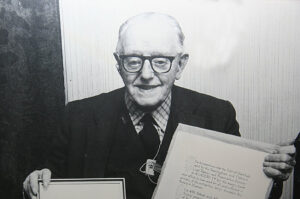Over the last hundred years and in particular the last fifty years the number of local museums has greatly expanded. The Lanman Museum, now in Framlingham Castle had its inception in the 1930s. The Museum is unusual in that it owes much of its origin and development to one man, Harold Lanman.

Harold Lanman (1893-1979) was a long established dealer of antiques in Framlingham. In the 1930s, he started collecting local artefacts which eventually formed the nucleus of the original Lanman Museum.
His singular devotion to the pursuit of collecting artefacts of local history interest goes back at least to his teenage years. In 1953 there was an exhibition organised by the Framlingham and Saxtead Local History Committee with eighteen members. They appealed for exhibits and were offered around seven hundred for display over two days in the Assembly Hall, Church Street. Eighty six people lent exhibits which ranged from a Roman coin to a De Dion Bouton motor car.
The exhibition was a great success, which lead to the proposal for creating a permanent museum. In 1955, the secretary Percy Stannard wrote to the Ministry of Works to ask whether a museum could be incorporated within the Castle Hall. If there was a response it has not survived, but clearly this avenue did not materialise, at least not for another thirty-nine years. The Museum did come to fruition in 1957, primarily through the endeavours of Harold Lanman and Percy Stannard. The Framlingham & District Local History & Preservation Society was created, for which the first constitution was drawn up in 1956. Under the Society, the museum was opened by the Earl of Cranbrook in a room on the Market Hill (now Akermans) which belonged to Potters. By 1969, these premises were no longer available, and a move was made to 11 Double Street, where it resided for ten years.
The Court House in Bridge Street then became available, and with professional help for new displays, the museum moved to the upper floor (above the present library) in 1979. Harold had stepped down as Honorary Curator in 1975 at the age of eighty two, and sadly died a few weeks before the ‘Lanman Museum at the Court House’ was opened by Sir Joshua Rowley Bt., the Lord Lieutenant of Suffolk.
Up to that time, the Museum had been run by the Framlingham and District Local History and Preservation Society. The new move had precipitated a change and a separate charitable trust “The Lanman Museum” was created to take over the running of the Museum.
Perhaps Percy Stannard’s letter must have risen to the top of the pile, as English Heritage offered the museum space in the Poor House in the Castle, and a move was made there in 1984, which is now its permanent home on the first floor. Today the Museum plays host to about fifty thousand visitors a year, and is fully accepted by English Heritage as an integral part of Castle facilities.
The original collection covered the late Victorian to Edwardian periods but it has since grown backwards to medieval times and forward to World War II. We are always looking to expand the collection – history is an ongoing process!
The collection policy is that all artefacts come from an area within a five-mile radius of Framlingham and notably the collection includes the entire Framlingham Weekly News which was published every Saturday from 1859 to 1938. The edition on display is changed frequently. The adverts in particular make fascinating reading as many of the shops are still in the town.
Utilising grants from the Victoria & Albert Museum and the Headley Trust we have purchased medieval gold jewellery found locally. This is now displayed in the museum, which also houses two impressive Faberge objects given to Sir Henry Thompson, surgeon to Queen Victoria. The dinner guest list from one of the doctor’s dinner parties is not only signed by George V but also by Sir Arthur Conan Doyle, the creator Sherlock of Holmes.
Other interesting displays include a funeral bier, traps (for both humans and animals), old shop displays and tools relating to trades in Framlingham that no longer exist such as shoe making. We are building up a clock collection as clock making was once a major business in Fram and any information about this would be most welcome. The photograph collection is vast, including a set of local pictures taken by John Self on glass. The glass plates cannot be displayed for conservation reasons but copies show town life at the turn of the last century. It is great fun trying to identify both people and places and many people have identified their relatives.
